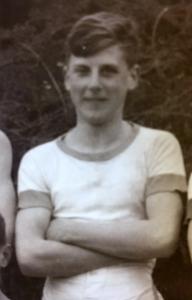
|

|
| Lieutenant John Anthony Cecil CHATFIELD (224011) | |
|
245 Battery, 62nd Anti Tank Regiment, Royal Artillery Date of birth: 4th July 1922 Date of death: 8th July 1944 Killed in action aged 22 Buried at Ryes War Cemetery Bazenville Plot VI Row D Grave 7 |

|
| John Anthony Cecil Chatfield was born in Kent on the 4th of July 1922 the son of the Reverend Albert Leonard Chatfield MC, Vicar of Laughton, and Gertrude Emily Louisa (nee Pressnell) Chatfield of Bosham Vicarage in Sussex. He was educated at St Michael's School, Uckfield and at Lancing College where he was in Olds House from May 1936 to July 1940. He gained his School Certificate in 1938 and 1st M.B Part II in 1940. He was a member of the Boxing Team from 1938 to 1940 and was appointed as a House Captain in 1939. He was a Corporal in the Officer Training Corps. He attended an Officer Cadet Unit before being commissioned as a 2nd Lieutenant from on the 17th of January 1942 and was promoted to Lieutenant on the 1st of October 1942. 245 Battery, 62nd Anti Tank Regiment landed on Juno Beach in the early hours of the 8th of June 1944. They were equipped with 12 M10 self propelled 17 pounder anti-tank guns and moved inland to a reserve position on the Reviers-Tailleville Road later that day. The following day they were moved to support the British 3rd Division and 6th Airborne Division in the eastern sector of the Allied bridgehead. On the 4th of July they were involved in heavy fighting in the unsuccessful attack on Carpiquet airfield. Two of their troops were then attached to the Canadian 9th Brigade for their part in "Operation Charnwood", part of the assault on the key position of Caen. At 7.30 am on the 8th of July 1944 245 Battery crossed the start line near les Buissons behind the Highland Light Infantry of Canada and advanced towards the heavily defended village of Buron. After a fierce and costly struggle the Canadian troops captured and held the greater part of the village and shortly after 9am the battery's vehicles were able to move through the rubble strewn streets to the forward edge where they deployed, with "A" Troop covering the southern and western approaches and "B" Troop facing southeast. Not long afterwards, the barrage of incoming shell and mortar fire grew heavier and a counterattack was launched by German armour. In the course of this a battlegroup of 20 to 30 enemy Mark IV and Panther tanks moved across the front of the gun positions of 245 Battery and in the ensuing action 13 enemy tanks were destroyed before the remainder withdrew to the southeast. During the battle John Chatfield was killed by shellfire near the village of Cussy, an incident which was witnessed by one of his crew, Gunner Thomas Bathe. Bathe was so affected by his officer's death that he suffered from shell shock and was affected by a stammer for the rest of his life. This action is regarded as one of the most celebrated British anti-tank engagements of the Normandy campaign. By the end of the engagement, six M-10s had been put out of action (four were later recovered), two officers and four other ranks had been killed, and a further six men had been wounded. Later in the day the three guns that were still serviceable joined the North Nova Scotia Highlanders as they passed through Buron and advanced to Authie where they were deployed along the left flank of the village. At 10pm the remnants of the two Troops were withdrawn to the north of Buron for maintenance and reorganisation. Caen fell the following day, a month behind its planned capture in the original allied plans for Operation Overlord. He is commemorated on the Bosham Village war memorial and on the memorial at St Michael's School, Tawstock in Devon. |
|
| Olds House |
Back